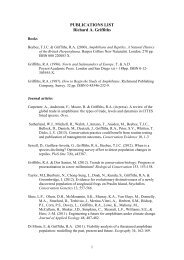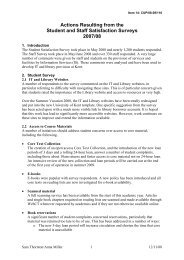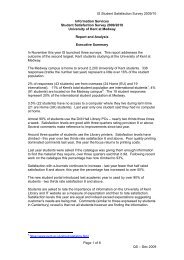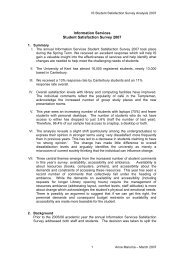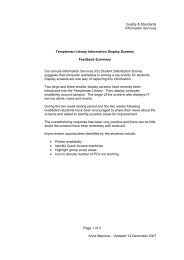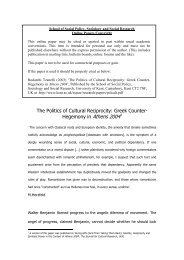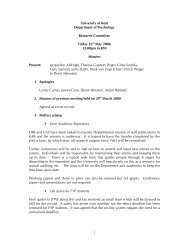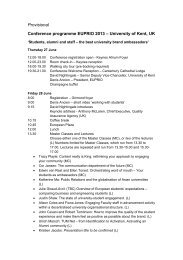The Million Pound Donors Report 2012 - University of Kent
The Million Pound Donors Report 2012 - University of Kent
The Million Pound Donors Report 2012 - University of Kent
You also want an ePaper? Increase the reach of your titles
YUMPU automatically turns print PDFs into web optimized ePapers that Google loves.
we have a joint executives meeting when all the Boots and<br />
Macmillan staff who are working on this project get<br />
together. That’s a lot <strong>of</strong> directors in one room! We talk<br />
about what’s happened so far, what’s coming up, and any<br />
issues that need unblocking.<br />
<strong>The</strong> fundraising was the easiest element to start with<br />
because Boots colleagues were very happy to throw<br />
themselves into it, and there’s a lot <strong>of</strong> tried and tested<br />
methods for fundraising in workplaces. <strong>The</strong> models are<br />
already there and both charities and companies have the<br />
skills to make them work. But it takes longer to set up a<br />
proper strategic partnership, that’s where there’s an<br />
element <strong>of</strong> co-creation. In the same way as you would with<br />
a major donor, you start by saying “what are we going to<br />
achieve together?”<br />
<strong>The</strong>se kinds <strong>of</strong> partnerships mean the charity becomes part<br />
<strong>of</strong> a company’s business solution, rather than just an<br />
organisation they want to throw cash at. Gone are the days<br />
when companies just chuck money at charities in return for<br />
a photo call with their chief executive handing a cheque<br />
over. Charities must <strong>of</strong>fer more than positive PR these<br />
days; they need to <strong>of</strong>fer real business benefits. But that’s<br />
not to say workplace fundraising is devoid <strong>of</strong> emotional<br />
engagement. We don’t want to get to a point where it’s<br />
about nothing but strategy because there’s a lot <strong>of</strong> fun,<br />
creativity and team bonding involved in raising money for a<br />
charity like Macmillan where the cause has touched a large<br />
percentage <strong>of</strong> the staff in any company you go into. It’s<br />
much harder for charities that don’t connect with the staff<br />
base.<br />
<strong>The</strong>re’s a whole range <strong>of</strong> ways that we report to our funders<br />
and demonstrate the impact <strong>of</strong> their support. We’re good at<br />
data, so we have a lot <strong>of</strong> statistics to illustrate how much<br />
money was raised, what we used it for, how many people<br />
were helped and what it achieved. We also take supporters<br />
to visit projects, like our new flagship building within<br />
<strong>University</strong> College Hospital, so they get more than just<br />
data – they can see and touch what their money is being<br />
spent on. That’s very powerful, as is introducing our<br />
funders to the people employed on our support line, in our<br />
centres, hospitals or hospices. If a corporate partner meets<br />
one <strong>of</strong> our frontline staff then they usually want to know<br />
what more they can do to support that person.<br />
Whatever the size <strong>of</strong> the donor and the size <strong>of</strong> their<br />
donation, we always need to be able to demonstrate why<br />
we needed that money and how we spent it.<br />
the MIllIon PoUnd donors rePort <strong>2012</strong><br />
I would advise corporate partners thinking about entering<br />
partnerships to understand why they want to do it and to<br />
realise that it’s ok to have a range <strong>of</strong> objectives. For<br />
example, if you want to increase footfall in your store then<br />
don’t feel you have to pretend it’s solely about making a<br />
donation to the charity. If you want your staff or customers<br />
to help raise money then give them some choice in<br />
choosing the partners and make sure they are passionate<br />
about it and feel they own it. People generally fundraise<br />
more enthusiastically for charities they feel more strongly<br />
affiliated with.<br />
I would advise charities not to let size, geography or lack <strong>of</strong><br />
experience stop them approaching corporates, because<br />
almost every charity can find a partner that will bring<br />
mutual benefits. Smaller, local charities might feel at a<br />
disadvantage compared to the bigger brand names, but<br />
they actually have an advantage when it comes to pitching<br />
to regionally based companies.<br />
Remember to leverage your networks, because everyone is<br />
an ambassador and could be in contact with your next big<br />
corporate partner, so encourage key stakeholders –<br />
including your staff, trustees and other donors - to be<br />
proactive and respond to opportunities.<br />
But the most important thing is to make sure the values <strong>of</strong><br />
the company align with your charity values, or it simply<br />
won’t work out for either side.”<br />
39



